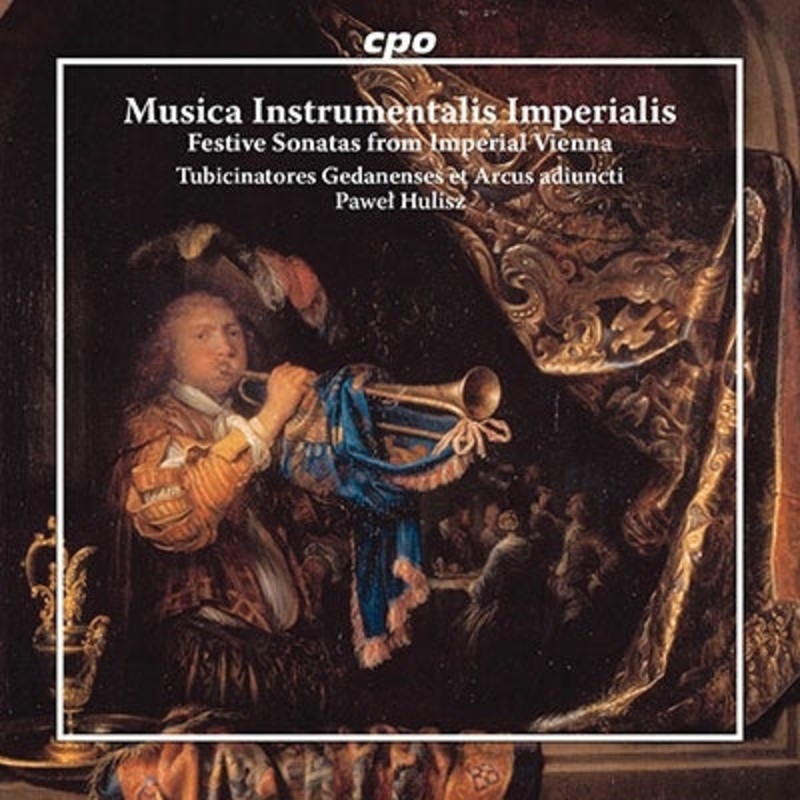
Credits:
Tubicinatores Gedanenses
Description:
Instrumental Music for the EmperorContentsFranz Ignaz Anton Tuma(1704-1774):.1-3. overture "for clarino" in C major - for 4 trumpets, timpani, string orchestra and basso continuo4-6. sonata "for trumpet and timpani" No.1 in C major - for 4 trumpets, timpani, string ensemble and basso continuo7-10. 3 partitas in F minor/F major - for string ensemble and pass bassWenzel Raimund Johann Birck(1718-1763):.11-12. sonata "for trumpet and timpani" in C major - for 4 trumpets, timpani, string ensemble and pass bassTuma: 13-15. sonata "for trumpet and timpani" in C major13-15. sonata "for trumpet and timpani" No.2 in C major - for 4 trumpets, timpani, string ensemble and basso continuo16-17. sonata for 3 voices/trio in C minor - for string ensemble and basso continuo18-20. sonata "for trumpet and timpani" No. 3 in C major - 4 trumpets, timpani,for string ensemble and basso continuoCarl Matthias Reinhardt(1711-1767):.21-23. sonata "for trumpet and timpani" in C major - for 2 trumpets, timpani, string ensemble and basso continuoTuma: 24-26.Sonata No. 4 in C major - for 4 trumpets, timpani, string ensemble and basso continuoJoseph Umstadt(1711-1762):.27-28. Sonata in B flat major for 3 voices - for string ensemble and pass bassIgnatz Pulstmann(c.1683-1723): 29-31.29-31. sonata "for trumpet and timpani" in C major - for 4 trumpets, timpani, string ensemble and pass bassUmstadt:.32-34. four partitas in D major - for 2 trumpets, timpani, string ensemble and basso continuoMatthias Ettl (1675-1725): 35-36.35-36. sonata "Concerto for four voices clarino" in C major - four trumpets, timpani,for string ensemble and basso continuoJohann Valentin Mader(1649-1719): Opera "Die bestndige Argenia37. sinfonia for 5 voices38. symphonia no.239. battle sonata40. symphonia no.4PerformersTubicinatores Gedanenses (old instrument ensemble...natural trumpet 4, timpani)Arcus adiuncti(Old instrument ensemble...Violin 2, Viola 2, Cello, Contrabass, Bassoon, Harpsichord)Recorded July 8-11, 2024 at Niebo Polskie, GdanskTotal recording time: 79 min.In the Habsburg Empire of the first half of the 18th century, the capital city of Vienna was politically stable, and the absolute monarchs Joseph I and Karl VI were active patrons of music, spending heavily on art and architecture, and the Viennese nobility invested generously in music. Court musicians played an important role, especially in religious music, and Johann Joseph Fuchs and Antonio Caldara were influential as music directors.At that time, the court required the performance of religious music called "Gala grande," which had to include trumpet and timpani (instrumental sonatas without brass instruments were composed as "sonata ordinarii," sometimes with trombone or viola). Sometimes a trombone or viola was added). The technical standards required of the court trumpet players were very high, especially for the trumpet.This album contains works by six composers. Performing are the TubicinatoresGedanenses, an ensemble of trumpet and timpani players from Gdansk, and the Arcus adiuncti, a string ensemble. 300 years ago along the Danube River, the The program takes us back to the Vienna of that time with a magnificent depiction of the grandeur that characterized the capital city along the Danube River 300 years ago. Accompanying the program as a bonus track is a selection of Maeder's operas from Riga and Poland.(Naxos Japan)
